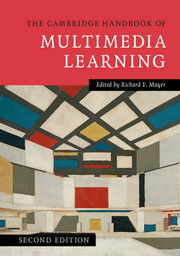Book contents
- The Cambridge Handbook of Multimedia Learning
- The Cambridge Handbook of Multimedia Learning
- Copyright page
- Contents
- Contributors
- Preface
- Acknowledgments
- 1 Introduction to Multimedia Learning
- Part I Theoretical Foundations
- Part II Basic Principles of Multimedia Learning
- Part III Advanced Principles of Multimedia Learning
- Part IV Multimedia Learning of Cognitive Processes
- Part V Multimedia Learning in Advanced Computer-Based Contexts
- Author Index
- Subject Index
Part I - Theoretical Foundations
Published online by Cambridge University Press: 05 August 2014
- The Cambridge Handbook of Multimedia Learning
- The Cambridge Handbook of Multimedia Learning
- Copyright page
- Contents
- Contributors
- Preface
- Acknowledgments
- 1 Introduction to Multimedia Learning
- Part I Theoretical Foundations
- Part II Basic Principles of Multimedia Learning
- Part III Advanced Principles of Multimedia Learning
- Part IV Multimedia Learning of Cognitive Processes
- Part V Multimedia Learning in Advanced Computer-Based Contexts
- Author Index
- Subject Index
Summary
Human cognitive architecture indicates the manner in which cognitive structures and processes are organized. In turn, that architecture can be used to hypothesize the relative effectiveness of alternative instructional designs. Over several decades, cognitive load theory has simultaneously identified those aspects of human cognition relevant to instructional issues and tested the resultant hypotheses using randomized, controlled experiments. The cognitive architecture used by cognitive load theory has continually been developed and refined over this period. Currently, that architecture is based on evolutionary principles. This chapter outlines the cognitive architecture used by cognitive load theory and provides a general indicator of its relevance to instructional design issues associated with multimedia instruction.
- Type
- Chapter
- Information
- The Cambridge Handbook of Multimedia Learning , pp. 25 - 148Publisher: Cambridge University PressPrint publication year: 2014

